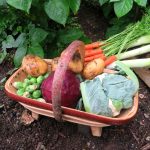How to grow... Leeks
Rocket Growing Guides

The great thing about leeks is that you get a nice long harvesting period. You can dig them up all through autumn and winter. They are nice and easy to grow too.
- Leek Growing Guide
How to Plant Leeks
- Leeks like a reasonably sunny, sheltered spot that doesn’t get too waterlogged. Fertile soil helps, so add plenty of compost before planting.
- You can grow leeks really well in a raised bed or traditional veg plot, and also in pots – choose pots that are nice and deep, and oblong in shape works well.
- Plant 15-20cm apart. If you are short on space, you can plant them closer together and harvest alternate leeks earlier in the season as baby leeks.
- You may find multiple seedlings growing in each plug. These can be carefully teased apart before planting.
- To plant your leeks, make a hole with a dibber or pencil 15- 20cm deep and pop your leek plant in. Fill the hole with water and just allow it to soak away. This will draw enough soil over the plant to cover the roots and help to blanch the stems as the leek grows.
- Label your rows so you know where your leeks are – they are easily lost when they are still young plants, especially if you have couch grass popping up.
How to grow Leeks
- During dry spells, water well to prevent the soil from drying out and to keep the soil a little cooler.
- Earth up (pull a little extra soil into a small mound around the leek) as they start to grow – this will give you leeks with more white on the stem.
- Keep leeks weed-free as much as possible. Using an onion hoe for regular weeding is best as this allows you to get in amongst the plants without disturbing their roots.
Common Pests and Problems with Leeks
- Brown/orange spots on leaves – this is likely to be rust, a fungal disease that affects plants like leek, onion and garlic. If you do see it on leeks, then it is best to harvest your crop before it worsens.
- Leek moth – You may first see the silk-like cocoons on the leaves, followed by white patches where leaves have been eaten. The damaged leaves soon start to rot. It is more problematic in the south, and in early autumn. If it affects your crop, it is best to grow them under insect proof mesh next season. If you do see cocoons, wipe them off.
- Leaf Miner – If you see rows of white spots on the leaves, it is allium leaf miner. This is the first sign, so if you do see this you may have caught it early – check the plants for eggs and remove any you find! The flies lay their eggs, and the larvae eat the foliage. The areas that have been eaten soon start to rot. October/November tends to be the worst time. If they are a problem in your area, try growing under insect proof mesh next time.
- Tough leeks – If, when you cut your leeks, there is a particularly tough centre to the stalks, then it is most likely that you have harvested after they have started to flower. Remove the tough part (use it in stock) and eat the rest.
How to Harvest and Store Leeks
- You can expect to harvest your Leeks any time between late June and mid August.
- Leeks can be harvested in autumn and winter as you want to use them in the kitchen. Use a garden fork to carefully pull them up without tearing them at the roots.
- They will store for several days in a cool room or in the fridge – if you don’t plan to use them fairly soon, they can just be left in the ground.
- If leeks are left in the ground for harvest over winter, it is worth mulching them so that the ground does not freeze/harden – this can be a nightmare if you want to harvest them on a frosty morning!!



